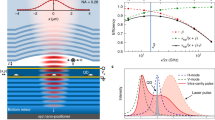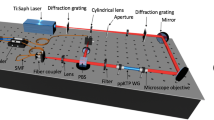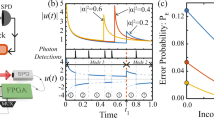Abstract
Noise is the price to pay when trying to clone or amplify arbitrary quantum states. However, the quantum noise associated with linear phase-insensitive amplifiers can be avoided by relaxing the requirement of a deterministic operation. Here we present the experimental realization of a novel concept of a probabilistic noiseless linear amplifier that is able to amplify coherent states at the highest levels of effective gain and final state fidelity ever reached. Based on a sequence of photon addition and subtraction, this high-fidelity amplification scheme is likely to become an essential tool for applications of quantum communication and metrology.
This is a preview of subscription content, access via your institution
Access options
Subscribe to this journal
Receive 12 print issues and online access
$209.00 per year
only $17.42 per issue
Buy this article
- Purchase on Springer Link
- Instant access to full article PDF
Prices may be subject to local taxes which are calculated during checkout




Similar content being viewed by others
References
Caves, C. M. Quantum limits on noise in linear amplifiers. Phys. Rev. D 26, 1817–1839 (1982).
Scarani, V., Iblisdir, S., Gisin, N. & Acín, A. Quantum cloning. Rev. Mod. Phys. 77, 1225–1256 (2005).
Gisin, N. Quantum cloning without signaling. Phys. Lett. A 242, 1–3 (1998).
Bruss, D., D'Ariano, G. M., Macchiavello, C. & Sacchi, M. F. Approximate quantum cloning and the impossibility of superluminal information transfer. Phys. Rev. A 62, 062302 (2000).
Ralph, T. C. & Lund, A. B. in Quantum Communication Measurement and Computing Proc. 9th Int. Conf. (ed. Lvovsky, A.) 155–160 (AIP, 2009).
Pegg, D. T., Phillips, L. S. & Barnett, S. M. Optical state truncation by projection synthesis. Phys. Rev. Lett. 81, 1604–1606 (1998).
Babichev, S. A., Ries, J. & Lvovsky, A. I. Quantum scissors: teleportation of single-mode optical states by means of a nonlocal single photon. Europhys. Lett. 64, 1–7 (2003).
Xiang, G. Y., Ralph, T. C., Lund, A. P., Walk, N. & Pryde, G. J. Heralded noiseless linear amplification and distillation of entanglement. Nature Photon. 4, 316–319 (2010).
Ferreyrol, F. et al. Implementation of a nondeterministic optical noiseless amplifier. Phys. Rev. Lett. 104, 123603 (2010).
Parigi, V., Zavatta, A., Kim, M. S. & Bellini, M. Probing quantum commutation rules by addition and subtraction of single photons to/from a light field. Science 317, 1890–1893 (2007).
Zavatta, A., Parigi, V., Kim, M. S., Jeong, H. & Bellini, M. Experimental demonstration of the bosonic commutation relation via superpositions of quantum operations on thermal light fields. Phys. Rev. Lett. 103, 140406 (2009).
Fiurasek, J. Engineering quantum operations on traveling light beams by multiple photon addition and subtraction. Phys. Rev. A 80, 053822 (2009).
Marek, P. & Filip, R. Coherent-state phase concentration by quantum probabilistic amplification. Phys. Rev. A 81, 022302 (2010).
Kim, M. S., Jeong, H., Zavatta, A., Parigi, V. & Bellini, M. Scheme for proving the bosonic commutation relation using single-photon interference. Phys. Rev. Lett. 101, 260401 (2008).
Zavatta, A., Viciani, S. & Bellini, M. Quantum-to-classical transition with single-photon-added coherent states of light. Science 306, 660–662 (2004).
Zavatta, A., Viciani, S. & Bellini, M. Single-photon excitation of a coherent state: catching the elementary step of stimulated light emission. Phys. Rev. A 72, 023820 (2005).
Lvovsky, A. I. Iterative maximum-likelihood reconstruction in quantum homodyne tomography. J. Opt. B 6, S556–S559 (2004).
Hradil, Z., Mogilevtsev, D. & Rehacek, J. Biased tomography schemes: an objective approach. Phys. Rev. Lett. 96, 230401 (2006).
Roch, J.-F., Poizat, J.-P. & Grangier, P. Sub-shot-noise manipulation of light using semiconductor emitters and receivers. Phys. Rev. Lett. 71, 2006–2009 (1993).
Grosshans, F. et al. Quantum key distribution using gaussian-modulated coherent states. Nature 421, 238–241 (2003).
Dowling, J. P. Correlated input-port, matter-wave interferometer: quantum-noise limits to the atom-laser gyroscope. Phys. Rev. A 57, 4736–4746 (1998).
Giovannetti, V., Lloyd, S. & Maccone, L. Quantum-enhanced measurements: beating the standard quantum limit. Science 306, 1330–1336 (2004).
Usuga, M. A. et al. Noise-powered probabilistic concentration of phase information. Nature Phys. 6, 767–771 (2010).
Duan, L., Lukin, M., Cirac, J. & Zoller, P. Long-distance quantum communication with atomic ensembles and linear optics. Nature 414, 413–418 (2001).
Duan, L.-M. & Guo, G.-C. Probabilistic cloning and identification of linearly independent quantum states. Phys. Rev. Lett. 80, 4999–5002 (1998).
Fiurášek, J. Optimal probabilistic cloning and purification of quantum states. Phys. Rev. A 70, 032308 (2004).
Wittmann, C., Andersen, U. L., Takeoka, M., Sych, D. & Leuchs, G. Demonstration of coherent-state discrimination using a displacement-controlled photon-number-resolving detector. Phys. Rev. Lett. 104, 100505 (2010).
Menzies, D. & Croke, S. Noiseless linear amplification via weak measurements. http://arXiv.org/abs/0903.4181 (2009).
Acknowledgements
A.Z. and M.B. acknowledge support from Ente Cassa di Risparmio di Firenze and Regione Toscana under project CTOTUS. J.F. acknowledges support from the Czech Ministry of Education under projects LC06007, MSM6198959213 and 7E08028, from the EU under the FET-Open project COMPAS (212008), and from the Czech Science Foundation under project GA202/08/0224.
Author information
Authors and Affiliations
Contributions
A.Z. planned the experiment and carried out measurements and data analysis. J.F. planned the experiment and developed the theoretical models. M.B. proposed, planned and coordinated the experiment. All authors discussed the results and implications of the experiment and contributed to writing the manuscript.
Corresponding author
Ethics declarations
Competing interests
The authors declare no competing financial interests.
Rights and permissions
About this article
Cite this article
Zavatta, A., Fiurášek, J. & Bellini, M. A high-fidelity noiseless amplifier for quantum light states. Nature Photon 5, 52–56 (2011). https://doi.org/10.1038/nphoton.2010.260
Received:
Accepted:
Published:
Issue Date:
DOI: https://doi.org/10.1038/nphoton.2010.260
This article is cited by
-
Exploring the Survival and Sudden Death of Quantum Correlations in an Open Atomic Laser System
Journal of Russian Laser Research (2023)
-
Distillation of Gaussian Einstein-Podolsky-Rosen steering with noiseless linear amplification
npj Quantum Information (2022)
-
Performance analysis of continuous-variable quantum key distribution using non-Gaussian states
Quantum Information Processing (2022)
-
Secure optical communication using a quantum alarm
Light: Science & Applications (2020)
-
A high-gain and high-fidelity coherent state comparison amplifier
Communications Physics (2018)



